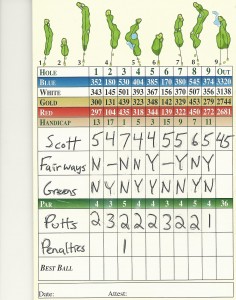Statistics from your round can help determine what area of your golf game should get priority at the practice range. There are a large number of stats you can track, but because too many stats just become noise, I like to track only a few simple stats for each hole.
- Fairways Hit (Driving Accuracy)
- Greens in Regulation
- Number of Putts
- Number of Penalty Strokes
These four statistics are easily tracked on a scorecard.
There’s one stat missing here that is commonly tracked by others and that is sand saves. A more appropriate stat, and one I may begin tracking, is green side saves. It is the percentage of times you get up and down when in close proximity to the green. The short game – pitching, chipping and putting – is the biggest area in which high handicap golfers can shave strokes off their game. I already track number of putts and tracking green side saves will not only provide feedback on my pitching and chipping but will also help further clarify my putting stats.
Let’s dig a little deeper into the stats I currently track.
Fairways Hit
This is called driving accuracy on the PGA Tour. You track whether or not your drive stopped in the fairway on each hole. At least in the way I presently track it, this is the least beneficial stat I track.
The quality of your shots off the tee can not be fully justified by a yes or no answer. You can miss the fairway to varying degrees. Your ball can be just off the fairway sitting up nice in the first cut of rough or it can be 100 yards back in the woods. Both of these count as a missed fairway. Golf Digest published a different system a few years back to track driving accuracy. It involves scoring missed fairways on a scale of zero to four. Find more information on this system by following the link below.
The Real Measure Of Driving Accuracy
This is an interesting system that does a better job of tracking driving accuracy. However, I choose not to use it. It’s more work and I prefer to keep things simple while I’m out on the course.
A yes or no answer to whether or not you hit the fairway still provides valuable information. After all, the goal is to hits as many fairways as possible. Just remember to look back on the fairways you missed. Did you still leave the ball in a good position? Did you strike your drives well today? Or did you mishit your shots of the tee and incur penalties? You need to focus on both proper club selection off the tee (you don’t always have to bomb your driver) and hitting these clubs at the practice range if you are getting into trouble off the tee.
Greens in Regulation
Greens in regulation, in my opinion, is the most important stat any golfer can track. Hitting a green in regulation means you are on the green and have a birdie putt or better. The ability to hit greens, along with putting, is the key to scoring low in golf but it also plays a big role in taking a high handicap golfer to shooting 90.
Missing too many greens puts a lot of pressure on your short game. When you hit greens in regulation, unless you four putt, the absolute worst you can score is a bogey. As an improving high handicap golfer, you should be hitting between 25% and 50% of greens in regulation depending on where you are at in your journey to shooting 90. If you are not in this range, you need to work on both club selection and hitting those clubs at the practice range.
Number of Putts
The number of putts you make on each hole is an important stat. After all, the putter is the most used club by a wide margin. It makes senses that putting provides the most opportunity to improve your scoring.
But this stat can also be misleading. A three putt from ten feet is much worse than a three putt from fifty feet. Also, a large number of holes with one putt does not necessarily mean you are scoring well. It could mean you are missing a lot of greens, chipping on and leaving yourself short putts.
There are other ways to track putts that have been developed. One is to count the length of the last putt on each hole and totaling them up for the round.
The more feet of putts you make during a round, the better you are putting. This isn’t fool proof either as one long putt can skew the numbers. Keeping things simple, I just count the number of putts per hole. I do however make sure to look at all my stats in relationship to one another.
Number of Penalty Strokes
Minimizing penalty strokes goes hand in hand with moving towards shooting 90. I track the number of penalty strokes I have on each hole.
At the end of the round, I can look back on the holes I had penalties on. There can be several different causes of penalty strokes. Sometimes you just hit a poor shot. Emphasize that club the next time you’re on the practice range. Sometimes it might be choosing the wrong club. Try hitting 3 wood off the tee on holes where your driver is getting you into trouble.
Keeping stats for your rounds is a good way to target areas for improvement in your golf game. Keep the number of stats manageable and remember to look at all of your stats in relationship to each other.


4 replies on “How Statistics Can Improve Your Golf Game”
How are you tracking “green side saves”? What makes up a shot that you would consider a green side save?
Hi J D. Thanks for the comment. A green side save shot is somewhat of a judgement call but I consider it a green side save shot when the ball is resting within about 10 yards off the green.
To track green side saves, I add another row on my scorecard and label it GSS. I will mark a Y for yes on a hole if a got up and down from a green side shot or a N for no if I did not. I will leave it blank if I did not attempt a green side shot.
how about breaking 80? to me the exact same thing. except in my case im hitting alot of GIR and only one OB today. but 3 puts period and you wont break 80. Oh sure o few 3 puts and you can. I bought a new Vokey this year and it hepled me GIR but I also bought a new putter but after only a month Im going back to my old putter. I have had good luck with 10-30ft putts but 2-10 has been bad especially any put 2=3 ft. Its feels like i have no touch at all and the ball comes off fast so I try to baby a put well that dont work. Speed is so important. Any thoughts.
Thanks for the comment Chad. I also struggle at times with short putts and end up jabbing at the ball when I try to baby it. I work on short back swing and follow through for short putts. The key is still following through even though it is a short one.